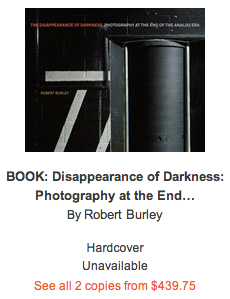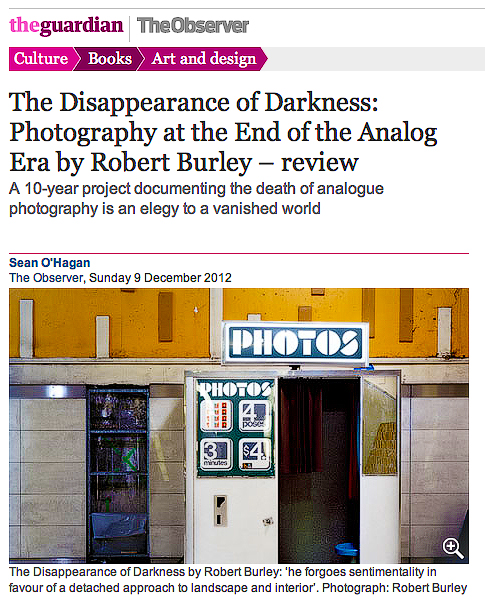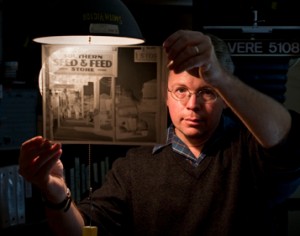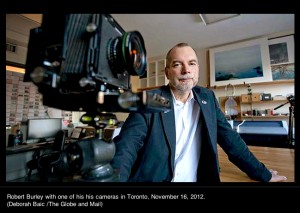David Gonzales of the Lens Blog wrote this heartfelt review of the book commenting on the radical changes affecting photography today.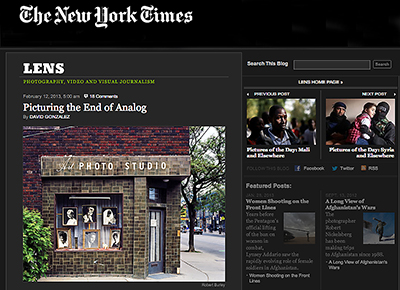
More books are coming soon!
All the major booksellers have sold out of my book but some of the lesser-known online book dealers are selling new and used copies for premium prices. However, my publisher has assured me that the 2nd print run is on its way and new books will be available on March 1st/13 through Amazon and other booksellers. If you’re in a rush, please contact the Ryerson Image Centre (the co-publisher) – they have some books available at list price plus shipping. Please email Christine Papantoniou at: c.papantoniou@ryerson.ca
Robert Burley speaking at the New York Public Library
“It is already a kind of elegy.” The Guardian
This recent review by Guardian writer Sean O’Hagan discusses the book as one that explores the end of materiality.
Will film disappear forever?
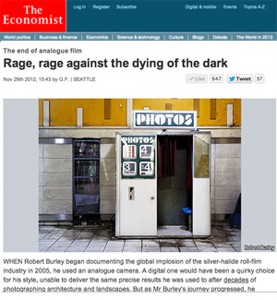 This question has been raised many times – in many emails I’ve received. For those who have read my book you’ll note that I don’t try to answer this difficult question. My personal hope is that film won’t disappear – I’d like to continue using it. However, I realized many years ago this decision won’t be up to me or any of the other artists that want to continue using film. This is a difficult and complex discussion – and for this reason I welcomed a review of my book by Economist writer Glenn Fleishman. Fleishman once worked for Kodak in the 1990’s – a time when it appeared as though the largest manufacturer of photographic products had the future impact of digital technologies well in hand. When I spoke with Fleishman, he immediately understood the idea behind my project and describes the book as, “full of poignant insights, both visual and literary, into a bygone technological era.”
This question has been raised many times – in many emails I’ve received. For those who have read my book you’ll note that I don’t try to answer this difficult question. My personal hope is that film won’t disappear – I’d like to continue using it. However, I realized many years ago this decision won’t be up to me or any of the other artists that want to continue using film. This is a difficult and complex discussion – and for this reason I welcomed a review of my book by Economist writer Glenn Fleishman. Fleishman once worked for Kodak in the 1990’s – a time when it appeared as though the largest manufacturer of photographic products had the future impact of digital technologies well in hand. When I spoke with Fleishman, he immediately understood the idea behind my project and describes the book as, “full of poignant insights, both visual and literary, into a bygone technological era.”
Fleishman experienced a lively response to his article from film users around the globe who suggested he (like me) was exaggerating and sensationalizing the demise of their medium. After all, there is still film being made and people are still using it so why shouldn’t it continue forever!? I was pleased to see him reply with this comment:
The future is now.
There is a point beyond which the industrial scale necessary to produce the chemicals, substrate, and final product at a price individuals are willing to pay will no longer pencil out. Film cannot be made both well and affordably (key point that) without a large-scale market. This is the reason for the demise of many well-loved films.
When an industry loses a massive portion of its market in a matter of years, and has the prospect of selling substantially less in each subsequent year, one has to wonder how long the industry remains viable.
The question remains: Can film be produced as an artist’s material in the future? I still don’t have a clear answer to this question. I have high hopes for black and white materials (thank you Ilford) but I fear my color negative films are not long for this world. A follow-up article in Digital Trends titled, “Economics, not digital, is what’s killing off analog film” was posted a few days later. Sadly, making film is not like manufacturing other anachronistic media (i.e. vinyl records) – it’s extremely complicated and without a large customer base – it becomes difficult to keep those factories running.
Library of Congress abandons the darkroom
A recent article in the Washington City Paper discusses a end-of-year decision by the Library of Congress to discontinue its longstanding service of providing the public with silver-gelatin prints created from the negatives in its photography collection. For the last fifty years this service has allowed individuals like myself to acquire masterpieces of twentieth century photography for a nominal sum. When I come downstairs each morning I confront a well-known Walker Evans photograph (Roadside Fish and Produce Stand with Young Men Holding Watermelons) hanging on my wall. It was created in 1936 near Birmingham, Alabama – as part of a commission for the Farm Security Commission that involved Evans along with numerous artists including Dorthea Lange and Gordon Parks, each photographing poor rural areas of the American South. A variation of this photograph can be found in the collection of the Metropolitan Museum of Art but I think I have the better version (it’s the one with young girl in the shadows gesturing to the camera in a kind of curtsy). The print was purchased from the Library of Congress in the 80’s and printed by a government darkroom technician who used the original negative created by Evans. The fact that my print comes from the object that was held, exposed and developed by Evans in 1936 suddenly becomes all the more the meaningful as the Library of Congress moves to an all digital system for researchers.
Second printing of the book is underway!
Over the last few days, I received emails and phone calls from people in the US trying to get a copy of my book. Amazon.com is sold out – as are most of the online booksellers in Europe. The good news is that the book has gone into a second printing and will be available in February/13. However, if you want to get one before then, there are still some copies available in Canada. As of today, Amazon.ca and Indigo.ca have the book in stock – though my contact at Raincoast (the Canadian distributor) tells me his warehouse is now empty. If this route fails you can also get the book through the Stephen Bulger Gallery in Toronto by contacting Natalie at: natalie@bulgergallery.com.
Interview on Marketplace
I was recently interviewed about the book by Kai Ryssdal on APM’s Marketplace
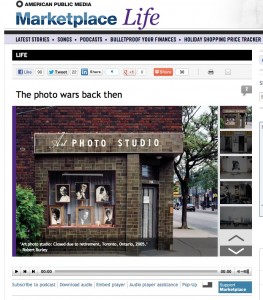
Behind the Silver Curtain
“Suppose they gave a revolution and only one professional photographer came …”
This article by James Adams from the Globe & Mail appeared last week.
THE BOOK LAUNCH!
Stephen Bulger Gallery, 1026 Queen Street West
December 5, 2012
5:00-8:00pm
Please note seating is limited for the conversation in the theatre. To ensure a seat pleases RSVP, and arrive early.
info@bulgergallery.com 416.504.0575
Opening Remarks by Doina Popescu, Director of the Ryerson Image Centre (RIC). A public conversation between Robert Burley and Dr. Gaëlle Morel, Exhibitions Curator at the RIC will begin at 6:00pm. This will be the first opportunity for Robert Burley to sign copies of his book in Toronto. The exhibition Robert Burley: The Disappearance of Darkness organized by the Ryerson Image Centre and curated by Dr. Morel will be on display at the RIC, January 22 to April 13, 2014. This book is co-published with Princeton Architectural Press.

